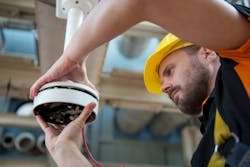How to do more security installations in less time
Editor's note: This article is sponsored by Bosch Security and Safety Systems.
In today’s fast-paced world, we’re always looking to accomplish more tasks and projects in less time. Gaining efficiency, streamlining, and reducing costs while increasing profits are common topics in business meetings in nearly every industry. With the continual pressure on price and cost – or business margins – and the shrinking pool of skilled labor in the security industry in recent years, these goals can become difficult to achieve.
Improvements in technology and product design that make systems easier to install and support can provide opportunities here – allowing dealers to service more customers in less time. From motion detectors that can be installed in just a few minutes to video products and tools that reduce setup and configuration by up to 75 percent, there are options available to help dealers and integrators reduce their labor costs on projects. This is especially important when working on large and complex systems.
Project Planning
Keeping track of a large video security project can be very time-consuming. The planning, configuration, installation and reporting of a video security project involves multiple tools and many hours to complete and document the process. It can include pre-configuration of hardware, assignment of IP addresses and secure passwords, management of on-site camera locations, resource and allocation of labor, installations, and status alignment throughout with both employees on the project team and with customers. Unexpected technical, logistical, or workforce issues, or even prolonged preliminary work, can be costly – extending project timelines and budgets and reducing profitability. It’s clear there is room for improvement to make these processes more efficient.
With software tools, such as project apps, available today, integrators can start the set-up and pre-configuration in the office without even having the cameras present. Using project plans and a set of IP addresses and passwords from the end user, the system integrator can enter or upload all of these details, as well as camera names and locations, directly into the app. This fast, simple project set-up creates a set of virtual cameras and eliminates the need for unboxing and re-boxing of products or pre-configuration and labelling. This can provide significant time savings – up to 30% – and the products can transfer directly from the manufacturer’s warehouse to the client’s location just in time for installation. Once the cameras are physically installed on site, scanning a QR code that contains the camera’s MAC address matches the virtual cameras to the real cameras, and the system integrator can upload the pre-defined settings to the camera.
Product Mounting and Installation
When it comes to mounting and installing products, getting the job done faster and more accurately can greatly improve the integrator’s bottom line.
For motion detectors, features like a removable lift gate terminal strip for easy wiring connections, an integrated biaxial bubble level for ensuring accurate placement, a self-locking two-piece enclosure, and a flexible mounting height with no adjustments needed can reduce install time to under six minutes per detector. Compare that to motion detectors lacking these features that can take from eight to eleven minutes to install. Installing detectors faster helps to reduce the time spent at each job site, which in turn enables technicians to complete more jobs each year, bringing more revenue to the integrator’s business.
In addition, cameras that separate the mounting hardware from the imaging module allow integrators to take advantage of lower-cost labor to not only pull cable, but to also install the mounting or base plates. When the integrator’s technicians arrive, they can make the cabling connections, and select and attach the imaging module with the desired resolution to complete the product installation in less time.
Remote Commissioning and Programming
Combine products with simplified installation with software tools for remote commissioning and programming to increase efficiency even further.
For example, IP cameras with remote commissioning functionality can enable installers to position the camera to capture the required field of view without having to touch the camera or lens. This can be done from the ground – making the inconvenient task of repeatedly climbing ladders a thing of the past – and with less people for each job. After the initial set-up, remote commissioning can also be used to adjust the field of view if the user’s requirements change during the project – even without a site visit.
For alarm panels, remote programming with advanced diagnostic capabilities reduces costs by allowing technicians to program or service systems or enable or disable certain functions without traveling to the customer’s facility. This reduces costs, as installation can be performed on site by technicians with lower labor rates, while programming can be done from the office to reduce the travel requirements for more senior staff. With some systems, the program can even be preconfigured and automatically downloaded to the control panel when the system is installed. Systems can also be connected using the cloud, so installers do not need to program the customer’s router or obtain a fixed IP address.
Between project planning tools, product features designed to simplify installation, and software for remote commissioning and programming, there are several ways to reduce your costs and increase efficiency on your security projects. When considering various security products for your next project, be sure to ask vendors how their offerings can help you do more in less time.
About the Author:
Jeff Swan is Vice President of Security Marketing – North America at Bosch Security and Safety Systems.




